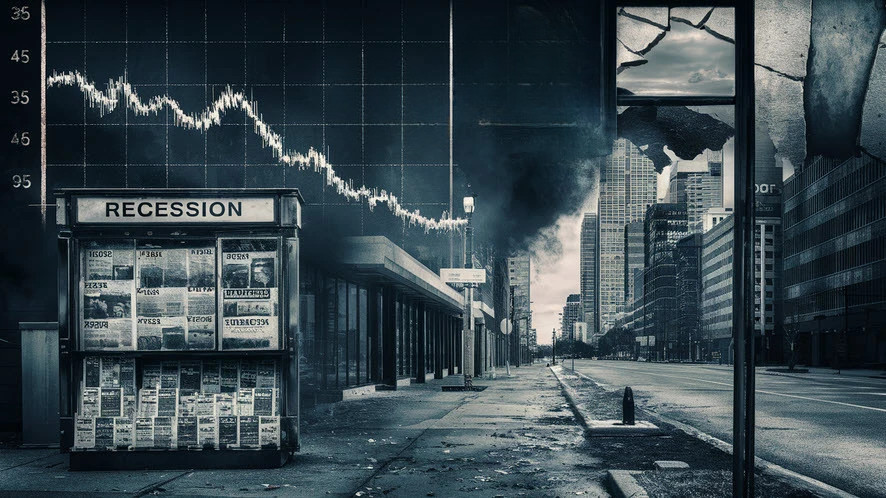Have you ever heard people talk about the economy slowing down and wondered what that means? Today, let’s explore if our usual signs of a recession are still dependable. The big question right now is whether the economy’s gentle slowdown could turn into a tough downturn. But the signals that typically offer clues look more unreliable than ever.
Why This Matters
Recession indicators are supposed to help us see when the economy is in trouble. But lately, these signs aren’t working like they used to. Many indicators have been triggered, yet the economy hasn’t taken a big hit. The pandemic and its effects on supply and demand have likely caused this confusion.
Flashback: The Past vs. Now
In the past, changes in temporary employment were a big clue about the economy. When companies stopped hiring temp workers, it usually meant a recession was coming. This pattern was true before the 1991, 2001, and 2008 recessions.
- Temp Jobs: Temp employment used to drop before a recession, then regular jobs would follow. But since March 2022, temp jobs have dropped by 16%, yet overall employment keeps rising. This disconnect shows how things have changed.
Temp Jobs Aren’t the Only Indicator
Another key signal is the inverted yield curve. This happens when it’s cheaper for the government to borrow money short-term than long-term, often predicting a recession. This curve has been inverted for two years now, the longest ever, but no recession has come.
There’s also the rule about two quarters of shrinking GDP meaning a recession. In early 2022, the U.S. economy shrank for two quarters, but overall, things like jobs and spending stayed strong. So, this rule didn’t work as expected either.
The Sahm Rule
The Sahm Rule says we’re in a recession if the three-month average unemployment rate rises by 0.5 percentage points over the past year. By June, it was close, at 0.43 points. However, the increase might be due to more people looking for work, not more people losing jobs. This makes the rule tricky to apply right now.
Reflecting on Changes
According to Claudia Sahm, who created the rule, the pandemic has caused unusual business cycles. Old indicators aren’t as reliable because the economic situation is very different now.
July Data
- GDP Growth: “The U.S. economy expanded at a rate of 2.8% in the second quarter of 2024, which is double the growth rate in the first quarter”. (FactCheck)
- Unemployment Rate: “The unemployment rate dropped back and has stayed lower, longer than at any time during the previous administration. However, specific July 2024 data is not provided.” (FactCheck)
- Inflation: “Inflation surged to its highest level in over 40 years. Consumer prices are up more than 19% overall, with gasoline prices rising by 46%.” (FactCheck)
- Recession Probability: “Experts put the odds of a recession by July 2024 at 59%, suggesting a near 3-in-5 chance of economic contraction.” (Bankrate)
- Stock Market: “The S&P 500 increased by 42.9%.” (FactCheck)
- Consumer Confidence: Specific data for July 2024 is not mentioned yet, but it’s an essential indicator to watch for signs of economic health.
- Housing Market: Housing market indicators are not provided in the available data.
- Business Cycle Indicators: No specific data for July 2024 is mentioned, but monitoring leading and lagging indicators is crucial.
- Yield Curve Inversion: The yield curve inversion, which historically predicts recessions, has been unreliable this time. (Yield Curve)
- Manufacturing and Trade: Manufacturing slowdown data is not specified.
- Recession-Proof Investments and Resilient Industries:
- Diversifying investments and considering sectors like healthcare, utilities, and essential services can help during economic downturns.
Inconsistencies in 2024 Recession Indicators
Strong Labor Market vs. Other Economic Indicators
- High employment rates and low unemployment figures suggest a robust economy.
- However, other indicators like GDP growth, consumer spending, and manufacturing output might be showing signs of weakness.
Inflationary Pressures
- Persistent inflation is typically a sign of economic overheating, which can lead to a recession.
- However, the Federal Reserve’s aggressive interest rate hikes to combat inflation could also slow down the economy too much, increasing recession risks.
Consumer Spending
- Strong consumer spending is often a sign of economic health.
- However, rising interest rates and inflation can erode consumer purchasing power, leading to decreased spending and economic slowdown.
Stock Market Performance
- A volatile stock market can indicate investor uncertainty about the economy’s direction.
- However, the stock market doesn’t always accurately predict recessions, and it can sometimes overreact to short-term events.
Global Economic Conditions
- Geopolitical tensions, supply chain disruptions, and global economic slowdowns can impact the U.S. economy.
- These factors can create inconsistencies between domestic and global economic indicators.
Leading vs. Lagging Indicators
- Leading economic indicators (e.g., manufacturing orders, building permits) might signal a recession on the horizon.
- Lagging indicators (e.g., unemployment rate, GDP) might still show strength, creating a conflicting picture.
Conclusion
In conclusion, many traditional recession indicators are not working well in the current economy. The pandemic has changed how these signals behave, making it harder to predict downturns. It’s a reminder that the economy is always evolving, and we need to stay flexible in how we interpret these signs.
Disclaimer: While there are some conflicting signals in the economy, it’s essential to note that predicting a recession with certainty is challenging. Economic indicators are complex and can be influenced by various factors.
Recent Posts:
